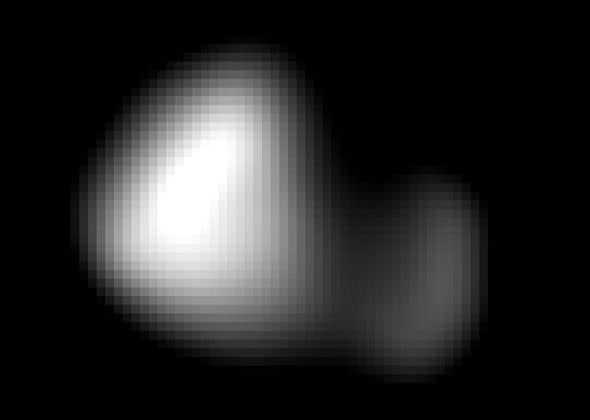A new image from the New Horizons spacecraft finally completes the entire Pluto family portrait, showing Pluto’s smallest (known) moon, Kerberos.
And surprise! It’s double-lobed!
That’s actually only mildly surprising; a lot of small asteroids and comets are not single, lumpy objects, but are instead shaped like bowling pins (or dumbbells, or dog bones). Something like 10–15 percent of all near-Earth asteroids are double-lobed (we have decent statistics on that particular group because they get close enough that we can measure their shape using radar).
These objects probably form from slow speed collisions between two small objects; they graze each other, slow, then merge to form a single, if stretched out, object. New studies of the comet 67P Churyumov-Gerasimenko show it almost certainly got its rubber ducky shape the same way.

Photo by NASA/JHUAPL/SwRI
The current thinking is that Pluto’s moons formed after a huge collision splashed vast amounts of material into space, which then coalesced into the moons we see now. Most went into Charon, but the leftover debris formed the smaller ones. In that case, slower speed collisions between objects forming from that material would have been pretty easy, so in fact it seems 50/50 that one of those smaller moons would be double-lobed. Looks like we got lucky.
Kerberos has another surprise, too: It’s smaller and brighter than expected. Previous Hubble observations indicated it was probably big due to its influence on the moons, and therefore dark. Instead, it’s small and shiny. The whole thing is about 12 kilometers end to end, with lobes 8 and 5 kilometers across (making it roughly three times bigger than the comet 67P). It’s likely covered in water ice, like the other Pluto moons, which is why it’s reflective. Why this contradicts the previous Hubble observations is a mystery.
The picture at the top has been heavily processed and enlarged to bring out details; each pixel is about 120 meters across, about the size of an American football stadium.
What’s funny to me is that this moon is named after Cerberus, the three-headed dog that guarded the underworld (the actual name “Cerberus” was already used for an asteroid, hence the odd spelling for Pluto’s moon). In reality, Kerberos only has two heads! So much for ancient myths.

Drawing by NASA/Johns Hopkins University Applied Physics Laboratory/Southwest Research Institute/Steve Gribben
But we’re not quite done yet.
New Horizons passed Pluto on July 15, still moving at about 14 km/sec relative to the icy world. So it’s still going! And astronomers aren’t ones to waste opportunities: Beyond Pluto lies the Kuiper Belt, a flattish donut-shaped region with millions of small, icy bodies. We’ve found more than 1,000 of them, but never seen one up close. Why not see if any are near New Horizons’ path?
Using Hubble, last year astronomers found a potential target for the probe. 2014 MU69 was chosen. It lies well over 1.5 billion km past Pluto, and its size is unclear (it depends on how dark it is; if its darker it’s bigger—shinier and it’s smaller) but probably in the 30 km range.
The cool news: On Thursday engineers on Earth commanded New Horizons to fire up its engines to swing its trajectory to pass MU69! AmericaSpace has details; it’ll take a total of four such burns to point New Horizons the right way.
I’ll note that this is the farthest course correction ever made from Earth. The probe is currently just over 5 billion kilometers from Earth. Wow.
New Horizons will pass MU69 in January 2019—yes, more than three years from now. Space is pretty big, and 1.5 billion km is a long, long way. But still, we’re threading the needle: The hope is to pass less than about 12,000 km from MU69, close enough to get decent details on its surface (and see if it has any small moons itself). If they pull it off, it will be the most distant close encounter in history.
If they are allowed to pull it off, I’ll add. This part of the mission hasn’t been approved by NASA yet. The New Horizons team will send a proposal to NASA for funding it in early 2016, and should know later that year if it’s approved. I know it’s weird to start the maneuvers before you know if you can actually do the mission, but in this case orbital mechanics overrules NASA bureaucracy; they had to do the burn now, or else they wouldn’t have enough fuel to do it later.
I suspect NASA will approve the follow-up. The Pluto encounter was huge news; people loved it, and the science from it was and continues to be amazing. The additional expense of taking a peek at MU69 is small compared with that, and the payoff potentially big. Seeing a Kuiper Belt object up close would be a huge bonanza for astronomers. These icy chunks are leftover from the formation of the solar system, and likely preserve a lot of information from that time, more than 4.5 billion years ago. Chance like this don’t come often. I think we’ll take it.
